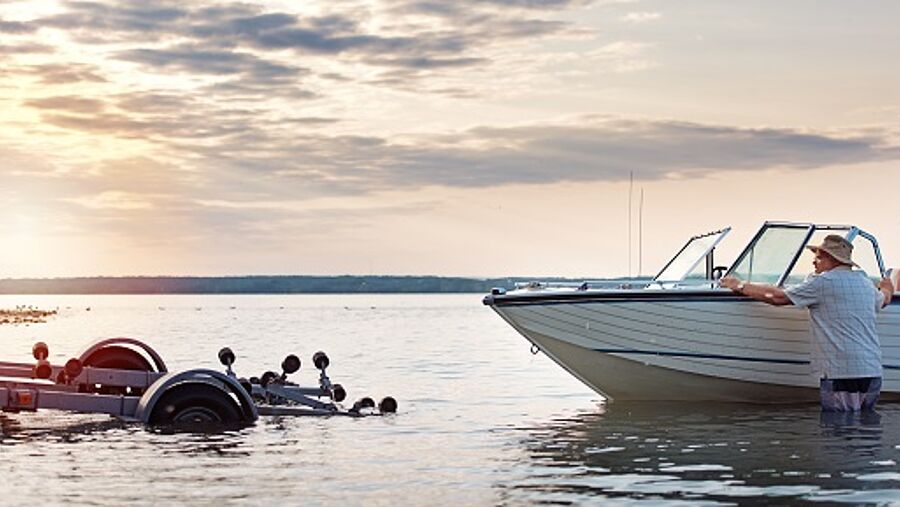Boat Trailer Challenge
Whether on the slip ramp or on the road - anyone who is dependent on regularly hauling their boat knows about the many small pitfalls and subtleties involved in dealing with a bulky trailer. As is so often the case here: Practice makes perfect. However, our insurance experts have summarised what untrained boat owners should pay attention to.

In principle, any vehicle that has a correspondingly designated trailer load is suitable for safely moving a sports boat trailer. This trailer load is noted in the vehicle documents and should be checked before any planned transport or slip operation. Whether your own driving licence entitles you to drive larger vehicles depends, among other things, on when you obtained your driving licence. You can obtain detailed information from the local driving licence authority or the police. In Germany and most European countries, the maximum values for a vehicle and trailer team are 2.55 metres for the width, 4 metres for the height, 12 metres for the length of the trailer and 18 metres for the total length of the vehicle and trailer team. If you want to travel in Europe, you will have to find out in advance about the national regulations and possibly apply for special permits.
However, each permit is of little use if the size of the team simply overtaxes the existing infrastructure. Damage caused by low bridges, tunnels or even branches that reach down to the road is unfortunately not uncommon in yacht transport. A correspondingly precise planning of the transport route should be carried out for longer journeys and when travelling abroad. The larger the yacht to be transported, the greater the impact on the driving behaviour of the towing vehicle. Getting to know the driving and braking behaviour of the team early on, on a quiet road, can provide the necessary safety at the wheel in such situations. Before loading a trailer with a boat, the brakes should be checked and tried out, as they often become stuck, especially if the parking brake has been applied for a long period of time. For trailers that come into contact with water - especially salt water - while slipping, it is advisable to drive them "dry" after slipping, as corrosion attacks the brake system.
It should also be ensured that the supports are correctly adjusted for the vessel: On most yachts, the weight is largely distributed on the keel, while the supports only provide lateral protection. On vessels with a lifting keel, however, as a rule no weight is allowed to act on the keel. Anyone who is undecided should ask the manufacturer or their trusted shipyard for advice. Before approaching the slip ramp, check the ground and ensure that your vehicle has sufficient grip. How far you can drive the trailer into the water depends on the nature of the ramp. In general, you should try to get the trailer as deep into the water as possible to facilitate the slip process. Make sure, however, that you do not come into contact with the water, neither with the rear axle of your vehicle nor with the socket of the trailer. If the vessel is loaded onto the trailer, make sure that the pads are made of a material that can dry off quickly when it rains or that drains off the water. The reason: Moist coatings can lead to osmosis on unprotected GRP hulls in the long term.
Sounds natural, but is sometimes forgotten: An additional and sufficiently long rope helps to regulate the position of the boat, even if the winch rope has already been attached. After loading the trailer, the yacht must be secured against slipping. For this purpose, lashing straps with a sufficient breaking load should be used.
For trailers that do not have a bow support, it is important to secure the vessel against forward movement. In addition, loose parts such as masts, hatches or rudders must be securely lashed so that they do not come loose during the voyage and endanger other road users. If the mast protrudes more than one metre beyond the trailer, it must be marked, e.g. with a red cloth during the day or with a red lamp in the dark. Before you start, check the lighting system, because the plug is often not properly attached to the towing vehicle, or the contacts are dirty or corroded.
One more tip: If you have a poor view to the rear, you should think about buying extended exterior mirrors, as is usual with caravan trailers. Of course, this article cannot meticulously list all the steps that are necessary for safe trailer driving. Those who are uncertain should catch up for the first slip procedure assistance with more experienced bridge neighbours or professional service providers.
Liability
Who is actually liable if damage is caused with my boat trailer?
If the boat is on the trailer (and is not connected to the vehicle), the boat's liability applies. Even if the trailer is moved by hand. However, there must be a direct connection with the use of the boat.
If the trailer is moved by hand without a yacht (no direct connection to the use of the boat) and damage occurs, this must be covered by the private liability insurance.
If the trailer is connected to a car, the risk for the entire team is automatically covered by the motor vehicle liability insurance. This also applies if the trailer detaches from the vehicle while driving.
If the trailer (without yacht) is parked, no liability insurance cover is available for it, unless a trailer liability has been concluded.
